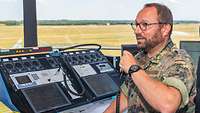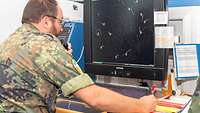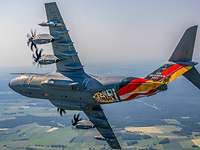Keeping an eye on the airspace above the Lechfeld
Keeping an eye on the airspace above the Lechfeld
- Date:
- Place:
- Germany
- Reading time:
- 2 MIN
Safety in the airspace would not be possible without air traffic controllers on the ground. One of them is Captain Wolfgang D. who keeps an eye on the American, Greek and German aircraft on the radar screen and from the tower during Air Defender 23.
“Originally, I just wanted to render ten months of military service but I didn’t know what would come next”, says Captain Wolfgang D. about his early months in the Bundeswehr. Since 2008, he has been a military air traffic controller (ATCArms Trade Treaty), a job comparable to that of civilian air traffic controllers. He sits at a radar screen and coordinates military air traffic in parts of Southern Germany. His air picture is composed of data from radar sets in Neuburg a. d. Donau, Munich, and Laupheim. In addition, D. works in the tower from where he coordinates the immediate airfield environment and aircraft movements on the ground.
The main difference to civil aviation is, as D. explains, “that the civilian controllers work either at the radar screen or in the tower, we do both.” This variety and the additional duties in the squadron or within the scope of exercise operations are what makes the job so exciting for him. “Primarily, I’m a soldier and then I’m a controller”, says the 42-year-old captain about his challenging job.
In an exercise such as Air Defender 23, the personnel working at the radar screens and in the towers must be fully focussed. Captain D., who is also known as “Whisky Delta” in the airfield jargon, explains: “With roughly 250 military aircraft from 25 nations, the already crowded airspace above Germany is even more packed.”
For better coordination, and to allow aircraft to fly through the airspace in all directions, it is divided into different height bands. If there are closures for military air traffic, the airspace is not inevitably closed at all altitudes. “In this way, an area assigned to air-to-air refuelling, for example, can still be used for civil aviation above or below allocated height bands”, explains the captain. What is peculiar during Air Defender 23 is that the airspace in the Lechfeld Air Base area, for example, can be used consistently from ground up to the beginning of the exercise airspace. This allows combat aircraft to climb to the highest flight altitudes within the shortest time possible and in almost vertical flight – which is a great benefit particularly in the crowded airspace of Central Europe.
The Lechfeld airfield serves as the starting point for various exercise participants. These include American A-10, Greek F-16, German H145M LUH SOFLight Utility Helicopter – Special Operation Forces and CH-53 aircraft. On some days, American F‑15 and F‑16 aircraft are added to this as well as the flights of transport aircraft conducted in connection with the exercise. Moreover, the southern airspace above the air base serves as a holding area and air-to-air refuelling area for what are referred to as COMAOs (combined air operations) in the western direction.





